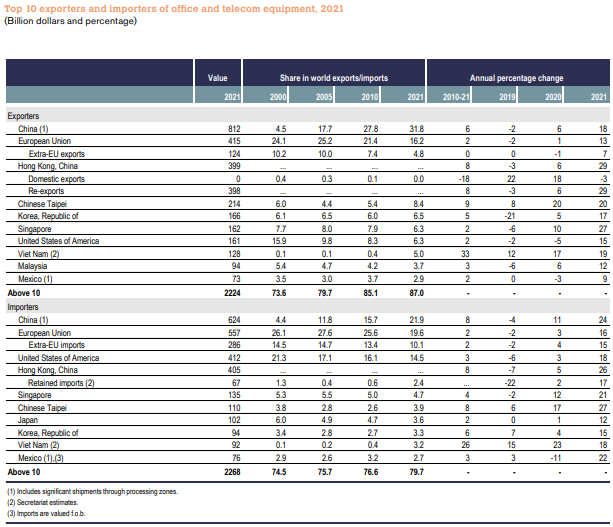The leading exporters of office and telecommunications equipment in 2021 were China, the European Union, Hong Kong, Taiwan and South Korea.
Above all, China exported these products worth $812 billion, followed by the European Union ($415 billion) and Hong Kong ($399 billion).

Telecommunications, computer and information services cover telecommunications services, which comprise the emission or transmission of sound, images, data or other information by telephone, telex, telegram, radio and television cable transmission, radio and television satellite, electronic mail, fax, etc., including business network services, teleconferencing and support services.
There are also computer services, consisting of hardware and software related services and data processing services; information services, including news agency services, such as the provision of news, photographs and feature articles to the media, as well as database services.
Other leading exporters were Singapore, the United States, Vietnam, Malaysia and Mexico, according to World Trade Organization (WTO) data.
Leading exporters
Globally and considering products across all sectors, merchandise trade grew 26 percent in value terms in 2021, with an estimated average price increase of 15 percent, accounting for the difference with the 9.8 percent increase in world merchandise trade volumes.
Particularly strong year-on-year growth was seen in key manufacturing inputs, such as iron and steel (+60%) and chemicals (+26 percent).
The value of global trade in pharmaceuticals and office and telecommunications equipment was up to 1.3 times higher in 2021 than in 2019, before the pandemic, mainly due to high demand for Covid-19 vaccines and increased telecommuting.
In the view of High Wire Networks, the telecommunications industry has undergone and continues to undergo significant changes due to technological advances, increased competition as telephone and cable companies converge, growing consumer demand for enhanced and bundled services, and increased government funding for broadband stimulus.
As a result of these factors, our customers’ networks are increasingly facing demands for greater capacity and reliability.
The proliferation of smartphones and other wireless data devices has driven demand for mobile broadband.
This demand and other technological advances have driven wireless carriers to upgrade their networks.

